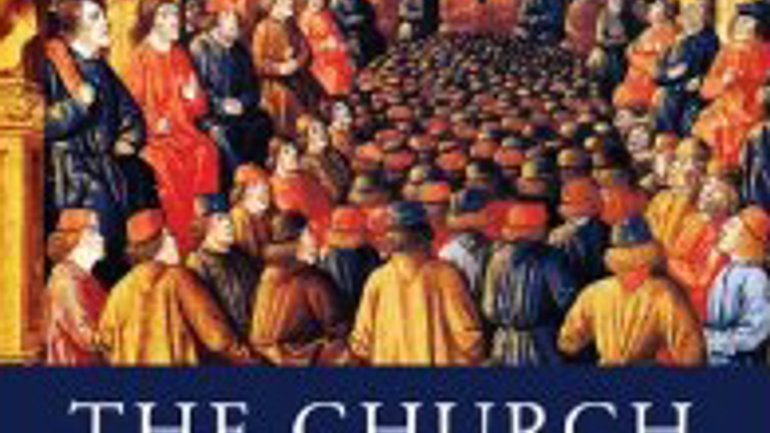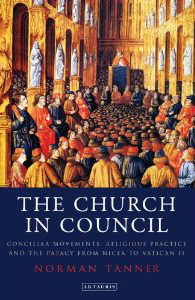Synodality and Primacy

 Known under a variety of interchangeable terms, synodality
Known under a variety of interchangeable terms, synodality, conciliarity
, or sobornost
is the phenomenon (inspired by the 34th Apostolic Canon
) of ecclesial governance of "the many" gathered together under the presidency of "the one" (variously understood as pope, patriarch, or metropolitan, inter alia). The forms which this has taken have varied over the centuries and in different contexts. Gradually, however, some consensus has emerged as to which councils are to be accorded which status--whether local, national, regional, or ecumenical. Sorting out which is which has never been an easy task, and continues to preoccupy scholars today, including Norman Tanner, author of significant works
in church history
, especially the history of the Ecumenical Councils, including the critical edition of the conciliar decrees. He has just published another book that I noted earlier:
The Church in Council: Conciliar Movements, Religious Practice and the Papacy from Nicea to Vatican II (I.B. Tauris, 2011), xi+249pp.
This is a fascinating collection of articles, all of which were published previously in a variety of forms. And those previous publications were, in the main, themselves previously given as lectures; all the hallmarks of oral provenance are still present in this book which, despite such a mouthful of a title, still has a very warmly conversational feel to it. Tanner is clearly a lecturer who tries to draw his audience into a dialogue rather than bore them into a condition of coma with a monologue. He succeeds most admirably here, and so readers should not be put off by his title into thinking that this is an extremely specialized work only for historians, theologians, or ecumenists. There is much here that a moderately educated Christian of any tradition will benefit from, not least a general overview of each of the seven Ecumenical Councils properly so called (Nicaea I in 325 to Nicaea II in 787) and the other fourteen councils of the Western Church sometimes considered by it to be ecumenical but more properly (as both the Council of Constance in 1417, and Pope Paul VI in 1974, noted) to be considered as "general" (generales synodos in occidentali orbe, to use the papal phrase).
Tanner offers several overviews of each of the first seven ecumenical councils properly so called. Those with little background in the history of the councils or their literature and consequences will find these overviews helpful though rather brief; the scholar will not find a lot that is new here--though I did wonder, in two or three places, about things Tanner raises but does not develop. E.g., his treatment of Nicaea II and iconoclasm rather overemphasizes, it seems to me, the role of Islam, which, in the light of recent and ongoing scholarship, recedes more and more into the background here. Tanner also does not address a very interesting question that Joseph Ratzinger raised more than a decade ago in his The Spirit of the Liturgy: has the West, in fact, really received and integrated the teaching of Nicaea II on icon veneration? Ratzinger seems to think it has not: there is, he suggested in The Spirit of the Liturgy
a latent stream of iconoclasm in the West, and not just in, say, Calvin's Geneva, but even in the Latin Church, perhaps now more than ever in the aftermath of Vatican II.
Rather off-handedly, Tanner asserts that "confirmation of the councils' decrees by the pope, the bishop of Rome, was important--indeed essential alongside that of the other patriarchal sees" (17). This is, of course, a standard Roman Catholic notion but it is surprising that such an historian as Tanner does not bother at all to demonstrate how and where this expectation of Roman confirmation developed, and whether it was always as consistently and neatly practiced as Catholic apologists today would certainly have us believe. As Aidan Nichols has recently argued in his Rome and the Eastern Churches, papal confirmation is undoubtedly important but one cannot say that the pope speaks for everyone or his voice alone is the voice of "the Church."
A few other areas in which I expected, but did not find, Tanner to have taken greater account of historical scholarship include his rather too brief coverage of the Council of Constance. Here, as I've noted previously, the person to pay attention to is Francis Oakley in his The Conciliarist Tradition: Constitutionalism in the Catholic Church 1300-1870 as well as many other works.
To my mind, Tanner missed a hugely important opportunity to develop a crucial point when he noted that "the Church today is less definitively bound to the decrees of the medieeval councils because of the lower status of these councils in comparison with those of the early Church" (30). Tanner has in mind here the councils of the Lateran, of Lyons, and Vienne, all of which, he says, dealt with disciplinary issues of relevance to the Western Church alone. But then he goes on to argue that
in the case of disciplinary decrees there is the additional reason that many of them dealt with contingent matters and therefore are, in principle, open to change. The same point applies, mutatis mutandis, to other decrees of a more practical nature, those concerning devotional life and even ecclesiology (30, my emphasis).
That latter point--about ecclesiology--is, in theory at least, very significant and its effects potentially far-reaching. It would have been fascinating to see Tanner apply this to, inter alia, Pastor Aeternus.
About that decree, in fact, Tanner makes some rather odd observations which, again, he does not substantiate or elaborate upon: "Whether the papacy, as portrayed in the decree, represents more the model of authority in the East than in the West may be debated. The decree did not try to base itself upon any secular models of authority, be they of East or West" (36). This may be debated, indeed, but I know of few today doing so. Most recent scholarship, in fact, strongly suggests that the model upon which Vatican I based itself was precisely a Western one, and a very political one: Hermann Pottmeyer, among others, has repeatedly suggested that Vatican I's model of papal primacy cannot be understood apart from nineteenth-century debates about the "sovereignty" of the nascent nation-state as it was emerging in France and the rest of Europe. Here the work of Joseph de Maistre
is very influential
. Another important volume to consult here is that of Klaus Schatz: Papal Primacy: From its Origin to the Present.
When we get to Vatican II, Tanner has done some valuable work in the acta and other documents surrounding the council. Here he unearths fascinating stories about Eastern Catholic, especially Melkite, influence at the council. Much of this has, of course, been published in French (L'Eglise Grecque Melkite au Concile, 1967, now helpfully translated here) and more recent works on Melkite influence are also available in English. But Tanner goes beyond the sometimes rosy portrait to show that the Melkites often led but on some issues ended up isolated from even fellow Eastern Catholics as well as the huge Latin majority.
One of the unintended (and generally unknown) consequences of Vatican II--especially the 1983 Code of Canon Law prepared in its wake--has been, as I've shown elsewhere, the downgrading of the prospects of regional and local synods or councils. Unlike the supposedly "retrograde" or "reactionary" council of Trent, the supposedly "progressive" and "reforming" Vatican II did not require, as Trent did, the holding of regular regional councils. About this Tanner rightly notes: "the demise of regional councils, and the culture of dialogue they embodied, has been one of the greatest blows in the history of the Church" (71-72). Part of the reason for this may be, he says later (clearly echoing Francis Oakley
), a "fear of the conciliar ghost [which] remains with us today in many quarters of the Roman Catholic Church. The restriction to an advisory role, and to a tightly controlled agenda, of the...biennial synods of bishops, is one example of this fear" (82). Later still Tanner notes something that others have recently argued
: the Catholic Church "can learn from other churches regarding the conciliar dimension of Church government" (117). I spent no little time surveying the conciliar government of Orthodox Churches in my Orthodoxy and the Roman Papacy: Ut Unum Sint and the Prospects of East-West Unity
.
All such collections usually entail some repetition and overlap, but in this book in several instances points are repeated verbatim not twice but thrice or even in quadruplicate. Had this book been more rigorously edited, it could easily have been reduced by at least 20%, and the result would have been a much more tightly written text. I've never understood why that does not happen more often. If one insists on publishing collections of previously published articles, there is no need slavishly to reproduce every word of an article as it originally appeared.
Still, at least one salutary effect of this repetition is that of making clear some key lines of thought that Tanner rightly draws our attention to. These include Tanner returning again and again to address the question of the dominance of the Church in Asia over the doctrinal development of Christianity as a whole. The first section of this book is entitled "Is the Church Too Asian? Reflections on the Ecumenical Councils." Here Tanner has cleverly and nicely turned on its head the oft-heard charge that Christianity is "too Western." Au contraire, he suggests, its doctrinal foundations were not laid in the West, but in the East--in Asia or, perhaps to be more precise, in Asia Minor. The involvement of "the West" in laying the doctrinal foundations--and much else besides--of Christianity was very minimal.
The final chapter in this book returns to that question of doctrinal foundations: "Greek Metaphysics and the Language of the Early Church Councils: Nicaea I (325) to Nicaea II (787). It is a short chapter (as all are in this book) that leaves the reader wishing for more. Tanner's conclusion is that we still don't have a complete picture of why the Church ended up adopting terms like physis, hypostasis, prosopon, and ousia. He also notes in passing that "Christianity, in a sense, invented the concept of the human person. There was no clear word in classical Greek for 'person'" (212). This is an idea that John Zizioulas has recently developed at much greater length in his wonderful book Lectures in Christian Dogmatics.
In sum
The Church in Council: Conciliar Movements, Religious Practice and the Papacy from Nicea to Vatican II is a fascinating collection perhaps of greatest interest to those new to the world of the councils. For those who want to get straight at the conciliar decrees themselves, and not take the rather meandering route of Tanner, with lots of fascinating commentary, I would recommend Leo Davis's book The First Seven Ecumenical Councils (325-787): Their History and Theology. But it would be a very profitable exercise to read the two together. One more, then, we are in Tanner's debt for his historical work, here as elsewhere, on those august bodies that clarified and established ad perpetuam rei memoriam the faith of the Church both East and West.
Dr. Adam DeVille
Джерело публікації: risu.org.ua







